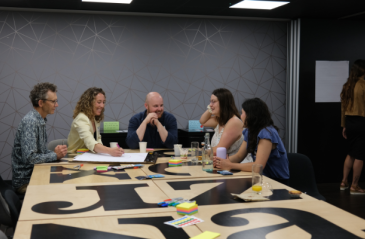
The information barriers holding back climate action and how to break them

Bardish Chagger is focused on ensuring her government taps the full potential of technology
Share articleChagger aims high: "What we need is our own moon shot for the government’s digital strategy."
Share articleWe need not fear disruption, says Chagger, but we should welcome it
Share articleWe put our vision for government into practice through learning partner projects that align with our values and help reimagine government so that it works for everyone.
Visitors to Canada are struck by many things. The friendly welcome springs to mind. So, too, does the country's sheer size and natural beauty. Online visitors to its government websites, however, may perhaps draw a different conclusion - it's fair to say there are more user-friendly sites out there.
But Bardish Chagger is here to change that. The Minister for Small Business and Tourism has used her first six months in post to chart a new course for digital, one which puts users at the heart of plans to embrace the next wave of technology. "I think data is really important because it allows us to know where we have been and where we want to go," she says. "Artificial intelligence, virtual reality and 3D printing are the types of technologies once only brought to life in movies and now we carry some of them in our pockets. So how much further can we go?"
Chagger is only six months into her first stint as a government minister but she is no political novice. Her first taste of public life came as a 13-year-old volunteer on the campaign trail and she has stayed closely involved in behind the scenes roles ever since. Now, aged just 36, she has marked her first period in office by meeting with more than 250 stakeholders and small business owners - reflecting the government's desire to consult and collaborate with Canadians in the hunt for fresh solutions.
These meetings, it transpires, have fired her determination not only to help small businesses grow through trade and innovation - and promote increased tourism to Canada - but also to do her part to ensure greater openness and transparency in government. And data and digital technology are key ways to achieve this.
"In Canada we harness the sun and the wind; we mine for ore and minerals; and we drill for oil and gas," she observes. "But what we need to do now is drill down into our data to extract value, inform decisions and, most importantly, form a government that develops better policy." To illustrate her point she cites the example of the census that took place in May - the largest information-gathering exercise in the country.
"It's true that in some rural and remote areas we still had people going door to door, recording headcount with a pencil and a clipboard," she admits. "But we also brought innovation to our methods and now more than 15 million households were invited to participate in this year's census. It's interesting about the census, because I remember that people used to complain about it and then it got taken away, but we wanted it back. It really puts a value on it."
With small businesses in her portfolio, it comes as no surprise to discover that reducing the administrative burden has emerged as one of Chagger's key priorities. "The more time that small business owners spend tracking down paperwork, the less time they have serving their customers and the less time they have with their families," she points out. "And the more money that small businesses spend on government administration, the less they have to expand, innovate and create the jobs that the economy needs."
Few would dispute these arguments, but many governments in many countries have sought to reduce administrative levels - and to little effect. How will she achieve maximum impact? Through the effective deployment of new digital solutions. "Part of the administrative burden on companies comes from the fact that different departments in different levels of government aren't allowed to share information with one another - for the very valid reason of privacy," she says.
"Well, what if every company could interact with the government in a single secured way? I think it's something we need to consider. It would allow us to be more productive and innovative, and this is a direction that we need to go. Our time is very important - and this is one thing that we don't seem to have enough of."
There's no doubt that Chagger's is an ambitious vision, befitting her palpable enthusiasm for what might lie over the horizon. "What we need is a major paradigm shift in information management to allow citizens to have one gateway for all their government relations needs in a secured fashion," she says. "What we need is our own moon shot for the government's digital strategy. From taxes to statistics, from subsidies to patents, everything could be accessible with one unified business identifier."
But talk is one thing - how will this actually happen? Chagger admits that she doesn't yet have all the answers but she remains convinced that the pace of technological change - especially when allied with the skill and determination of Canadians themselves - means that anything is possible.
"I've seen hackathons that have produced fully-developed plans with the accompanying software already coded in one weekend," she points out. "We know that government can't move that fast but we are working hard to catch up. And one of the things I do every chance I get is to encourage people to celebrate not only the successes but the failures as well - to see what has been learned, to value the experience gained, and to pledge to do better next time. Failure is just success waiting to happen and it's what leads to disruptive technology."
Chagger strongly believes that disruptive technology offers a pathway to huge progress and is something that should welcomed, not feared. "Once upon a time, the car was a disruptive technology and we don't have a problem with it today," she recalls. "It's just a matter of thinking differently. These technologies are crucial for the advancement of our economy - to change the way things have been done and do it better. Disrupting technology and disrupting systems are the goals of innovators. Government, innovators and entrepreneurs need to work together more closely than ever before."
Such collaboration, she declares, will underpin and accelerate Canada's digital evolution. "We need to look not just at what we're going to do, but where we are headed," she concludes. "Instead of worrying about the past, we should be predicting the future - embracing it before it gets here."
While only time will tell if she achieves her aims, Canada's digital practitioners have been warned: it's time to strap themselves in and get ready for the ride ahead.











